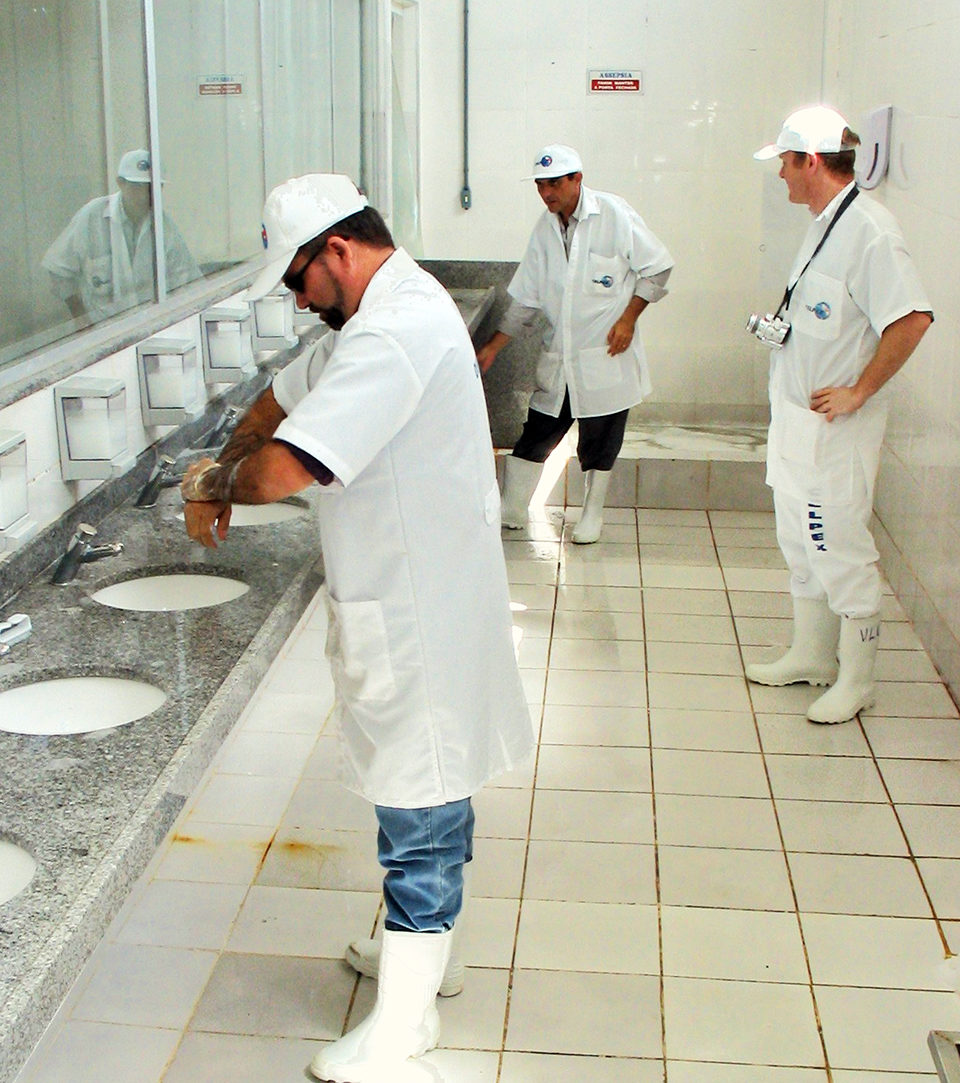Reinforce taught hygiene behaviors

How can shrimp-processing plants in lesser-developed nations maintain high levels of employee hygiene and sanitation? The answer, of course, is employee orientation.
An employee who understands the repercussions of unwashed hands, contagious illness, or a dirty floor is an employee far more likely to wash, report illness, and take care to clean the floor. Furthermore, from a broader standpoint, the socially responsible processor’s influence in the community can be used to spread the health benefits of improved hygiene throughout the local population.
Willing compliance key
At well-run plants, processors need to depend on employees’ willingness to follow seemingly ridiculous rules about washing hands, wearing certain clothes, keeping noses covered, and a myriad of other employee sanitation and hygiene practices. Work populations who understand the reasons behind these requirements more likely comply than those forced into work habits that seem mysterious to some. Although many plants have instituted rigorous monitoring systems, such monitoring must be combined with willing compliance on the part of the workers to ensure hygiene standards are maintained.
Unfortunately for processors, engendering understanding of hygiene concepts and changing hygiene practices in some rural populations is not straightforward. Simple training lessons are usually insufficient to effect changes in the work forces.
Over the years, international organizations such as the World Health Organization, nongovernmental groups like CARE, and national governments have determined that real change in hygiene habits is only possible through creative teaching. Incorporating direct participation, the teaching must be based on community knowledge and practices, and allied with local support and access to basic infrastructure.
Cooperative education
The task would seem insurmountable, but realistically, processors are usually familiar with the communities that supply plant staff. Local hygiene practices and infrastructure limitations should be well known. Plant managers can develop not just orientation programs that are effective in the community, but determine needs to provide washing facilities and showers for workers who may not have water at home.
Effective, participatory training programs can be developed with leaders from the processing plant job population using simple posters, interactive games, and teaching lessons that build on community practices to effectively improve hygiene standards. Plants can also work with local schools, training elementary school teachers and providing educational posters and materials to spread the message of improved hygiene to young children.
Training materials available
Training materials and methods are available on the Internet through the World Health Organization, nongovernmental organizations like Institut Pasteur, and a host of other sources. Books and training guides can be ordered, as well. Processors do not have to start from scratch, but can build on proven methods to improve hygiene, some tailored specifically to the regions where the plants are located.
Many national organizations are able and willing to work with processors to improve community hygiene practices. Under the auspices of Procter and Gamble, Institut Pasteur made a series of colorful posters and interactive games that explain how harmful bacteria can thrive in the home. Though originally developed for schools, this material can easily be adapted for use in processing plants, as well.
Typical posters show the importance of washing hands, caring for water sources, and dealing with infectious diseases. Such materials are available at little or no cost through the Internet. Processors can also request help from local government authorities who may have teaching materials for both business and community.
Encourage change
Processors can reinforce taught hygiene behaviors within the plant environment. Formal on-site training is complemented by plant infrastructure to encourage bathing with soap and appropriate hand cleansing. Posters placed in lockers and wash areas also reinforce behavior. Monitors can be stationed at entrances to work and bathroom areas, and in processing areas.
Initially change is difficult and complicated, but with time, workers will acknowledge that improved hygiene habits are not arbitrary, but sensible, beneficial, and ultimately should be implemented at home.
(Editor’s Note: This article was originally published in the November/December 2006 print edition of the Global Aquaculture Advocate.)
Now that you've finished reading the article ...
… we hope you’ll consider supporting our mission to document the evolution of the global aquaculture industry and share our vast network of contributors’ expansive knowledge every week.
By becoming a Global Seafood Alliance member, you’re ensuring that all of the pre-competitive work we do through member benefits, resources and events can continue. Individual membership costs just $50 a year. GSA individual and corporate members receive complimentary access to a series of GOAL virtual events beginning in April. Join now.
Not a GSA member? Join us.
Author
-
Monica Drazba
Aquaculture Certification Council Certifier
Mirador de Sto. Domingo #84
Managua, Nicaragua
Tagged With
Related Posts

Health & Welfare
Biosecurity practices on fish farms need beefing up
Biosecurity measures and preventive strategies are essential in any biological production chain. Properly planned and implemented biosecurity programs will enhance animal health, production and economics.

Responsibility
Cooperative compliance in the Philippines
Compliance with E.U. food laws was beneficial to aquaculture in the Philippines, but increased costs also initially created inequities for small farmers.

Responsibility
Certification programs for aquafeed manufacturing
Private aquafeed certification standards have been developed to bring trust and demonstrate responsible industry practices among aquafeed manufacturing stakeholders.

Intelligence
Critical decisions for shrimp harvesting and packing, Part 1
Harvesting a crop of shrimp is a critical step for any shrimp farming venture. Several months of efforts and resources to properly raise a quality crop have already been invested, and this quality must be preserved. The decision to harvest involves consideration of various factors.


